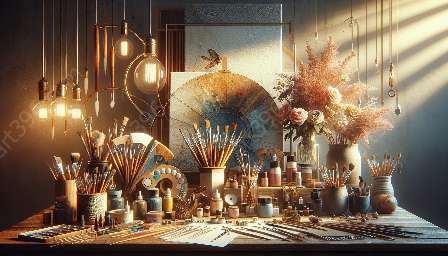Oil painting is a timeless art form that has evolved over the centuries, with traditional and modern techniques offering unique approaches to creating stunning works of art. In this comprehensive guide, we'll explore the differences between traditional and modern oil painting techniques, and delve into the essential oil painting supplies and art & craft supplies needed to master both styles.
Traditional Oil Painting Techniques
Traditional oil painting techniques have been practiced for centuries and are steeped in history and tradition. Artists using traditional techniques often adhere to classic methods of layering and glazing to create depth, texture, and luminosity in their paintings. Key elements of traditional oil painting techniques include:
- Underpainting: Artists start with a monochromatic underpainting to establish the values and composition of the artwork.
- Layering: The layering of translucent oil glazes allows artists to build up the colors and create a rich, luminous effect.
- Brushwork: Traditional oil painting often involves the use of various brushstrokes to convey texture and form, from delicate detailing to bold impasto.
- Mediums: In traditional oil painting, artists utilize natural mediums such as linseed oil and damar varnish to achieve specific textures and finishes.
Mastering traditional oil painting techniques requires patience, skill, and an understanding of art history and classic methods. It's a deeply rewarding approach that allows artists to connect with the rich heritage of oil painting.
Modern Oil Painting Techniques
Modern oil painting techniques embrace innovation and experimentation, offering artists the freedom to explore new approaches and materials. While respecting the foundations of oil painting, modern techniques often incorporate contemporary tools and methods to achieve bold, expressive results. Some key characteristics of modern oil painting techniques include:
- Expressive Mark-Making: Artists often utilize unconventional tools and techniques to create bold, dynamic marks and textures in their paintings.
- Texture and Mixed Media: Modern oil painters may integrate mixed media and non-traditional textures to add depth and interest to their work.
- Fast-Drying Formulas: Some modern artists opt for fast-drying oil paints and mediums to expedite the painting process and encourage spontaneity.
- Abstract and Conceptual Elements: Modern oil painting techniques often embrace abstraction and conceptual storytelling, allowing artists to explore personal narratives and emotions.
Experimentation and innovation are hallmarks of modern oil painting, offering artists the opportunity to push the boundaries of traditional techniques and express their unique visions.
Oil Painting Supplies
Whether you're drawn to traditional or modern oil painting techniques, having the right oil painting supplies is essential to achieving your artistic goals. Here are some key supplies every oil painter needs:
- Oil Paints: Invest in a high-quality range of oil paints in various colors to build a versatile palette for your works.
- Brushes: Explore a variety of oil painting brushes, including rounds, flats, filberts, and palette knives to achieve different textures and effects.
- Canvas or Panels: Choose high-quality canvases or painting panels for a reliable surface to work on.
- Mediums and Solvents: Stock up on linseed oil, turpentine, and other mediums and solvents to adjust the consistency and drying time of your paints.
- Palette and Palette Knife: Invest in a sturdy palette and a mixing knife for blending and manipulating your oil paints.
Art & Craft Supplies
In addition to specific oil painting supplies, artists can enhance their creative practice with a range of general art & craft supplies. Here are some versatile supplies that can complement your oil painting endeavors:
- Sketchbooks and Drawing Supplies: Explore a variety of sketchbooks, drawing pencils, and erasers to develop your ideas and compositions before translating them to canvas.
- Mixed Media Materials: Consider incorporating mixed media elements such as collage papers, pastels, and markers to add depth and interest to your paintings.
- Protective Gear: Invest in protective gear including aprons, gloves, and respiratory masks to ensure safety when working with oil paints and solvents.
- Workspace Organization: Keep your studio organized with storage solutions, easels, and lighting to create a conducive environment for your art-making process.
By integrating these art & craft supplies into your practice, you can enrich your artistic exploration and expand your creative possibilities.
Conclusion
Whether you're drawn to the time-honored traditions of traditional oil painting techniques or the dynamic innovation of modern approaches, both styles offer endless opportunities for artistic expression. With the right oil painting supplies and art & craft supplies at your disposal, you can embark on a fulfilling journey of creativity and self-discovery, mastering the techniques that resonate with your vision and style.

